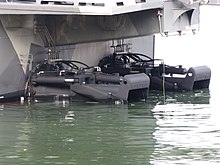Karlstads Mekaniska Werkstad
Karlstads Mekaniska Werkstad AB (KMW) was a machine factory in the Swedish city of Karlstad . It was founded in 1860 by Gustaf Adolf Andersson as a small workshop for the production of cast parts and small machines and converted into a stock corporation in 1873 .
history
Production was extensive from the start and included agricultural machinery, steam boilers , traction engines and railroad accessories . From the 1880s onwards, equipment for the paper and pulp industry was primarily manufactured in Karlstad , as well as water turbines , steam engines and steam ships . The factory was one of the first workshops in Sweden to introduce electric lighting in 1884. The dynamo was driven by a self-made steam engine via a drive belt.
Kristinehamns Mekaniska Verkstad built steam locomotives until 1893. That year the economic situation was so bad that the company management thererentedthe production hall with machines and cranes to Karlstads Mekaniska Verkstad . An order that has since been received for a steam locomotive for Hellfors bruk in a similar design to the locomotives that have already been delivered was therefore built by Karlstads Mekaniska Werkstad in Karlstad. It was the only locomotive that left this factory building.
Kristinehamn Mekaniska Verkstad was acquired by Karlstads Mekaniska Verkstad in 1897 . Locomotives, including a third machine for Hellefors, continued to be built in the factory there.
From 1899 production developed with more modern water turbines . The production of these water turbines and regulators was relocated to the Kristinehamn plant in 1902. In Karlstad, the focus was on building machines for cellulose production . The first water turbines rarely had more than 200 to 300 hp. However, the aggregates built quickly became more effective. As early as 1902, a turbine in Strömsnäs Jernverk in Degerfors delivered 1500 hp. A few years later, the turbine plant was the largest of its kind in Scandinavia .
In 1906 a test rig was set up with which the hydraulic properties of turbines of various types and speeds could be examined. In 1914 a new laboratory was added to test turbine models with small dimensions. The workshop in Kristinehamn supplied a large part of the systems for the Swedish hydropower plants in Trollhättan , Älvkarleby and Untra . Deliveries were also made abroad, such as to Svir in Russia , Rio Cinca in Spain , Sagami in Japan or Waihi in New Zealand .
When the Austrian Viktor Kaplan launched his turbine with adjustable impeller blades in 1913, the Kristinehamn factory received the monopoly for the manufacture of Kaplan turbines in Sweden. The first turbine was commissioned by the Swedish state for the hydroelectric power station at Lilla Edet in 1922 and delivered in 1926. At over 90 percent, the efficiency was very high and marked a global breakthrough for this type of turbine.
In 1920, when KMW merged with Myrens Verkstäder in Norway, the new company Kamyr AB was created . The new company became the world market leader in the manufacture of production systems for bleaching paper and later for machines for the manufacture of paper pulp. Johan Richter, an engineer employed in the company, received almost 800 patents in this area. The company still exists today and is a world leader as a Metso group.
Propeller gondolas , so-called KaMeWa propellers , were built in the interwar period . This market segment was taken over by Rolls-Royce , which sells the propeller pods and the so-called jet drive today. Many ships in the civil and military sectors, such as the ferries Deutschland and Prins Richard , the Queen Mary 2 or the Thetis class, are equipped with such drives.
Between 1936 and 1986 KMW was part of the Johnson Group . The manufacture of equipment for the paper industry was taken over in 1986 by Valmet , which has also been part of the Metso group since 1999 . Vickers took over the construction of propellers .
Today there is no more turbine construction in Kristinehamn. The old building, office and workshop belong to GE Energy (Sweden) AB . The workshop is closed and most of the rooms are rented to other companies. The collections in the Technical Museum in Stockholm contain a large number of archival materials , pictures and objects from the KMW.
Individual evidence
- ↑ Kamewa propeller at Rolls-Royce ( Memento from April 15, 2012 in the Internet Archive )
literature
- Aktiebolaget Karlstads Mekaniska Werkstad. 1873-1933. Petersson, Karlstad 1933.
